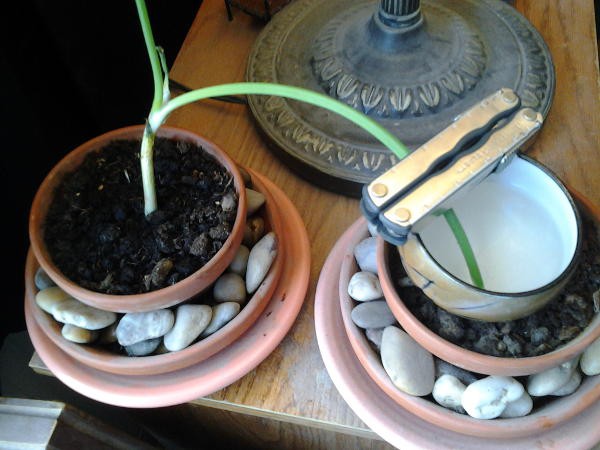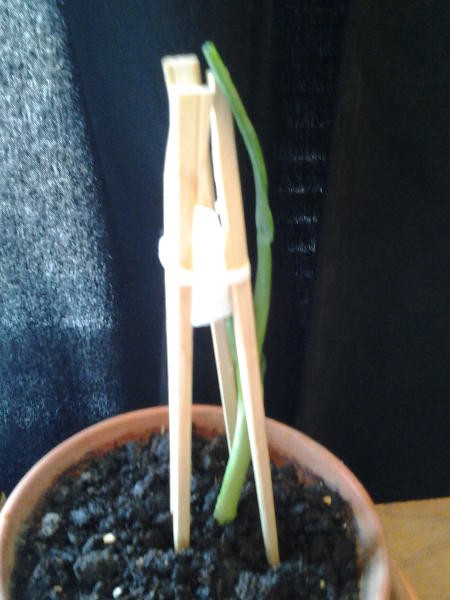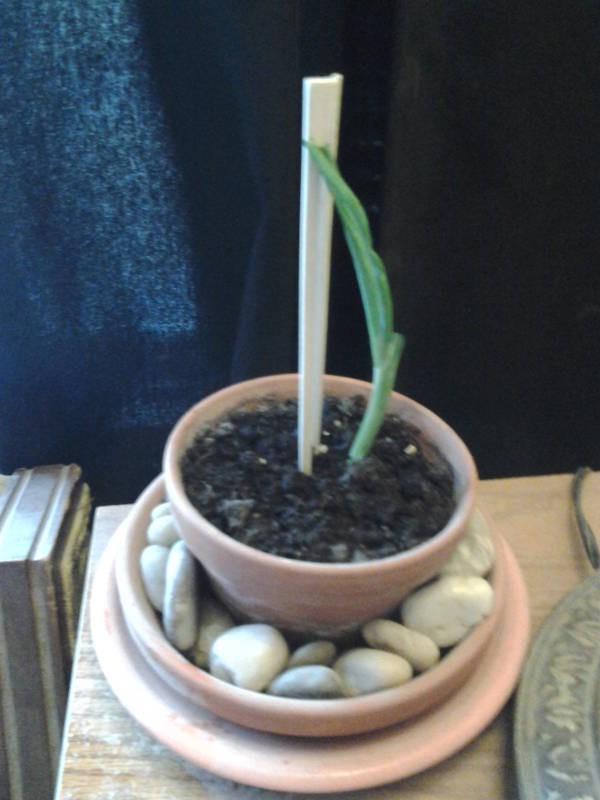-
My Onion Wears A Tinfoil Hat
04/24/2015 at 02:57 • 0 commentsIt is very concerned about CIA mind-control rays. Also, this is a relatively easy way to keep it mostly in the dark.
![]()
So this is the same feeding method 3, foliar feeding by submerging leaves in sugar water. I'm using plastic wrap to keep dust out of the sugar water, hopefully slowing the time it will take for fungus to take over, and it also holds the leaves down.
The plant has seemed pretty healthy, like it was growing well, despite the submerged portion (maybe just the new growth?) turning white, so I've decided to take it dark by covering it in aluminum foil. It's not perfectly isolated from light, but if it grew a fat onion bulb this way, I'd be satisfied that it would grow in total darkness from this sort of leaf-immersion foliar feeding (of course, I'd set up a more strict demonstration).
This was a green onion from the grocery store, so the bulb is still very small. I'd say it's smaller now than when it started (I think it has been spending stored energy to grow). I think it has been putting its energy into growing roots and leaves. I did not sprout the roots before planting in soil, and I can't really observe the root growth easily because it's in soil. Keeping the roots in water would probably have been smarter.
I'll miss this cheerful little plant growing in the light. It was funny, reaching all around, in every direction as it grew.
Incidentally, green onions are really easy and cheap to grow at home. You don't even need soil, they will just grow with the bulb in some water, if you put them by a window. You can pull leaves off, and they will keep growing. Nutritious and tasty greens and herbs are often easy to grow with little light or space because of their low energy content. It's a shame that people with empty windows ever lack fresh vegetables because they think they can't grow anything for themselves in an apartment, or during winter, and think of fresh vegetables as expensive.
Maybe someone else would like to do a project of cheap garden curtains. Really get the cost down and convenience and attractiveness up, try to make it interesting enough that everybody hears about it. I wonder what already exists along these lines. I've only really seen herb-garden kits, but I haven't done much looking...
-
Considering Vinegar
04/18/2015 at 05:27 • 0 commentsI'll have to consider vinegar (acetic acid) as another possible feedstock.
Using a bacteria that accepts electrical feeding, these guys are aiming for a sunlight-to-chemical-energy conversion process 30 times more efficient than leaves:
https://newscenter.lbl.gov/2015/04/16/major-advance-in-artificial-photosynthesis/
Of course, they don't need to use sunlight. S. ovata can be fed from any electrical power source. I'd like to play around with this myself.
This sort of thing being developed is why I think we should be making an effort to bypass the leaves of plants. Leaves are cheap, but not efficient (and far too sensitive to environmental conditions).
Acetic acid is very closely related to acetyl-CoA, so this is another thing, like pyruvate or ethanol, which plants might accept as a source of carbon and energy, to make sugar from.
One thing that interests me about acetic acid, which is largely unrelated to this project, is that you can easily get it to decompose into methane and CO2, with very simple equipment. So the pure stuff (called "glacial acetic acid", since it freezes around room temperature) can be used almost as liquid form of methane. Easier to store and handle than cryogenic LNG, anyway, although as a fuming acid, it's not entirely benign. Production of acetic acid (plus an oxygen store like a peroxide or nitrate) might make a good basis for the energy economy of a Mars mission, especially if it can be used for food production as well as fuel.
So far, my list of things to try is: sucrose, dextrose, corn starch, potato starch, tapioca starch, ethanol, vinegar, and pyruvate. Pyruvate's kind of a last resort for me now. It's available as a salt in supplements, but it seems expensive and likely a hassle to extract.
Back in the world of experiments, my onion plant's submerged tip is losing its color. I think that method 3 is going to be a failure. I was not expecting much from these crude methods, but I'd feel silly if I learned later that something like this was all I needed to do. I wonder about an aeroponic system, where the plant is turned sideways so its roots can be misted with fertilizer while its leaves are misted with sugar. I should at least give that a try.
-
Feeding Method 3
04/16/2015 at 17:21 • 0 commentsThis poor onion was suffering from mold around the base. I spilled too much sugar into the soil, and kept it too wet in the dark.
I removed the feeding apparatus, and gave it a few days in the light, so the mold would die. I'm noticing a general problem here, that fungus is everywhere, and unlike plants, have actually evolved to gobble up external sugar. I will have to learn more about how plants protect themselves from having fungus grow into them.
I'm trying a new method, of simply dipping the cut tip in sugar water (there's a chip out of the sugar-water cup, so the plant is not being squished):
![]()
This time, I'm making no effort to isolate it from light. I won't know for sure from this kind of experiment whether it's actually working, but I will be able to see if the sugar-water is causing obvious harm. Not killing the plant seems like an important thing to learn.
This is fairly thin sugar-water. Syrup might work better. I know you can store syrup at room temperature for a long time without having fungus grow in it, while sugar water is eventually going to ferment. I'll have to give that a try, too.
I've come across an interesting page on DIY microfluidics, which I think is the right kind of thinking, if not specifically applicable methods, for making a grafting interface:
http://science-practice.com/blog/2015/01/29/low-tech-microfluidics/
-
Cottonball Feeding
04/07/2015 at 19:58 • 0 commentsI am altering the deal. Pray I do not alter it further.
![]()
Now I've got a bit of cotton stuck down the cut tube of the onion, and a wad of cotton on top of it (from little cotton pads I had; I'll have to pick up some actual cotton balls too, since the pads are kind of annoying), held up with chopsticks and twist-ties. Right now the cotton's just wet, since the tube has still got sugar syrup in it, but I'll add sugar to the water later.
Same onion. I figured I didn't want to leave it and see what would happen, since the top of the cut tube was shriveling. So I cut off the least healthy looking parts and decided to try this way to keep the cut-off end wet.
On the research end of things, I found this interesting paper, on making a lab-scale bioreactor for syngas to ethanol:
http://www.ndsu.edu/fileadmin/aben/SYNGAS_FERMENTER.pdf
A wood gasifier makes syngas from wood (and should be able to run on inedible straw and other agricultural waste). Because it works by partial combustion, it doesn't care about the cellulose/lignin distinction (lignin is the tougher part of wood, and a problem for digesters). This is an oldish technology that pops up on farms when oil, and therefore conventional liquid fuels, gets expensive, because it's actually fairly straightforward to convert trucks and tractors to run on it.
You don't need to run a fermenter to make ethanol from syngas (it's simple molecule, there are abiotic chemical pathways), but it's probably the easiest thing for a small operation.
So this might be the basis for a workable low-tech pathway from indiscriminate plant matter, which is abundant and easily stored, to fresh food. If you can make a wood gasifier out of mud and clay, and clay pot fermenters and other bioreactors, this could be really low-capital.
I wonder how hard it would be to fully feed people off of wood and straw, with simple equipment that can all be made with hand tools and fire, with starter samples of the right organisms, and maybe some cheap stuff like plastic sheets and staples...
Raising edible mushrooms and termites for chicken feed seem the simplest things. It's amazing what termites and fungus can eat. Can people live with mushrooms as a staple? Could they be happy with it? What else besides chicken and mushrooms do they need for a healthy and satisfying diet? Anyway, I'm drifting too far afield.
Wood to syngas to ethanol... then what can we feed the ethanol to, and how? What else can we feed the syngas to, and what can it make that's useful?
As I mentioned in the project summary, there are companies already developing industrial-scale commercial applications of methane or syngas to food (or at least to animal feed):
http://www.unibio.dk/what-is-uniprotein%C2%AE/
http://www.lanzatech.com/innovation/technical-overview/
This is important technology, with potential to increase the supply and lower the cost of food, and I'm glad to see it developed. But I also think that companies like this have an interest in limiting their technology to the large factory.
I'd like to see this sort of thing put to practical use on the individual and small-business scale, at a do-it-yourself level of complexity and unencumbered by patents. That way, it can develop faster and be used for more purposes.
-
First Experiment
04/07/2015 at 00:29 • 0 commentsDear Internet,
Today I stuffed a green onion full of sugar like a pixie stick, to see if this is a way to make an onion which is bigger and not green.
Am I a real science-ist yet?
![]()
Actually, I used sugar water, and it was probably mixed too strong. It kind of shriveled on me within the first ten minutes. Then I spilled it in the soil and had to move the onion to another pot. This is soil for violets I had sitting around. I have no idea if it's suitable for onions.
I'm not prepared yet to do any proper experimentation, but you've got to start somewhere, to build momentum if nothing else. I don't want this to just be a looking-things-up project.
The onion is currently in a dark closet. If this one works, I will be very surprised.
Post-Agricultural Food Production
Growing palatable, natural food from arbitrary energy sources without the lossy intermediate of shining light on chlorophyll.
 Darrell Johnson
Darrell Johnson


